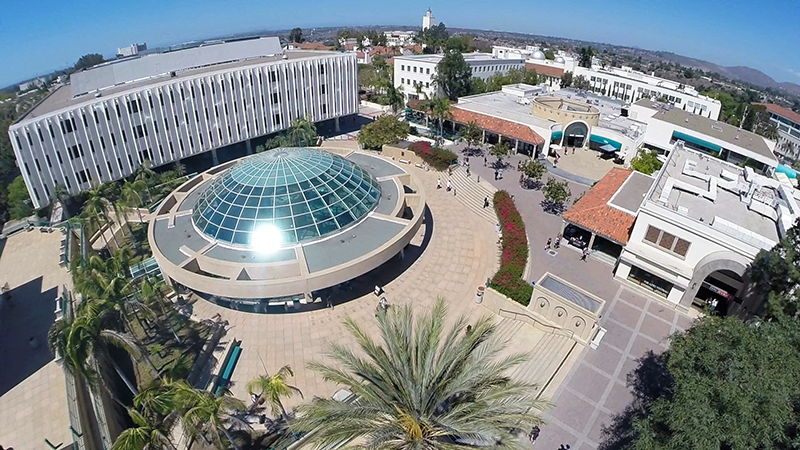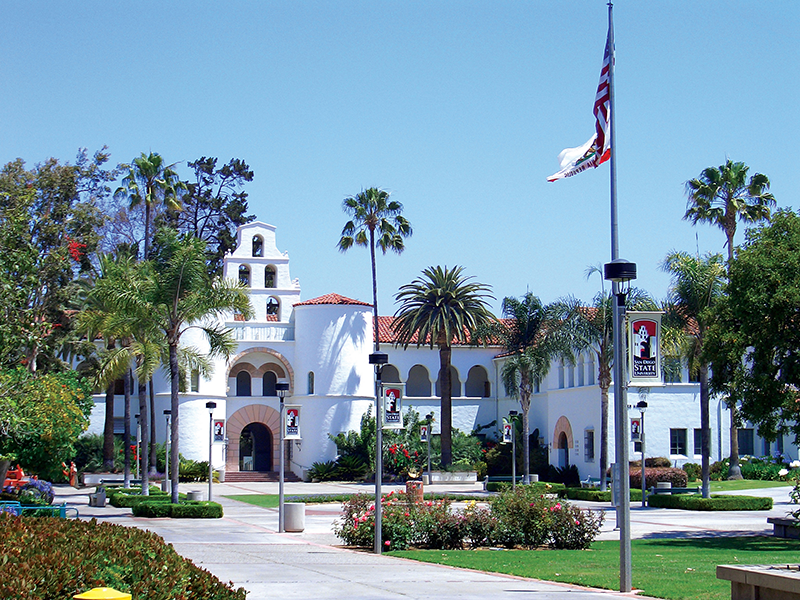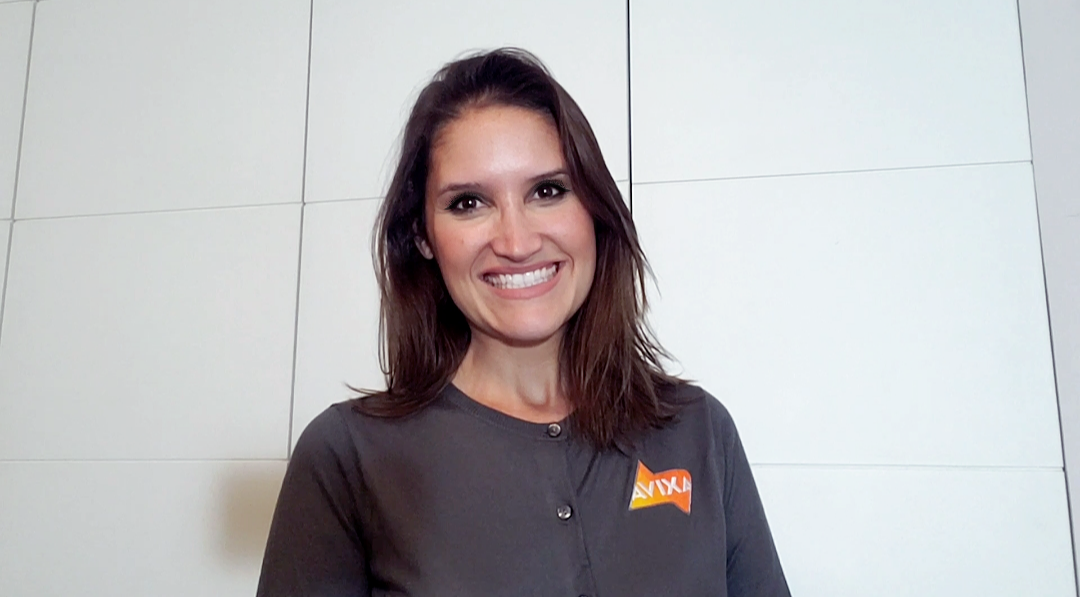Road to the Congreso AVIXA 2021: The San Diego State University Online Lessons Challenge
This article is a preview of the case story that the San Diego State University team will present during the next AVIXA 2021 Congress: Technologies for Education Today and Tomorrow, which will take place virtually from April 27 to 30.
 SDSU Hepner Hall, by SDSU
SDSU Hepner Hall, by SDSU
The challenge that more than 36 thousand students and thousands of professors from San Diego State University (SDSU) continue with their educational activities, despite the multiple restrictions imposed by COVID-19, would not be possible without the efforts of its Instructional Technology Services (ITS) department. Two of its leaders, Rudy Arias, Associate Director of Learning Spaces and Faculty Support, and Aurora Velasco, Support Lead at the ITS, tell us about the key projects that have contributed, since the beginning of 2020, to the success of the SDSU Flex institutional plan. This initiative offers an experience of connectivity and flexibility so that the university community can continue with the academic program, courses, and activities in the best possible way.
The Context
The Instructional Technology Services (ITS) department is in charge of providing all the necessary technology to facilitate the educational process and supporting the university community in its implementation and practical use.
With a permanent team of 25 people, plus student volunteers, ITS serves the two SDSU campuses located in the Californian cities of San Diego and Imperial Valley.
The ITS divides its functions into six main areas:
- The technological equipment for the learning spaces, their operation, and maintenance.
- The management of the loan of computer and audiovisual equipment.
- The Learning Management System (LMS) program.
- The capture and archive of lectures for later consultation.
- The production of educational content on video.
- The Faculty Instructional Technology Center (FIT Center), in which teachers get support and training in the use and development of technological tools.
 ITS Smart Classroom Training
ITS Smart Classroom Training
Rudy Arias mentions that during the first weeks of 2020, his focus was on the LMS transition project, as SDSU had decided to migrate from Blackboard to the Canvas platform. They were beginning to experiment with integrating Zoom into physical spaces and moving forward with the lesson capture program. Besides, they continued with the classrooms' equipment plan, installing various tools such as cameras to capture documents and blackboards.
"It seems like it was a long time ago that we had the first news of COVID-19. In the beginning, we thought that the restrictions would be for a few days, maybe a week," remembers Arias. "But then the first restrictions were announced, and the lockdown would be for an indeterminate time, so we had to make decisions in a very agile way because we had to execute the necessary changes and adaptations so that the courses did not stop."
The Challenge
Faced with confinement and sanitary restrictions, the SDSU launched a flexibility and connectivity plan to continue university activities. The SDSU Flex seeks to maintain the community experience on campus, with a mix of in-person, virtual, and hybrid actions. Lessons should facilitate the participation of more than a thousand teachers and 36 thousand students, motivate face-to-face communication, and offer resources adapted to students' needs so that their learning is not compromised.
The SDSU Flex plan relies heavily on the responsiveness of the ITS department. For Rudy Arias and his collaborators, this challenge represents a permanent project that includes different factors like training for the faculty, technical support, mass adoption of the Zoom platform, device management, and classroom equipment.
 SDSU Dome, by Andrew Galang
SDSU Dome, by Andrew Galang
The Project
Faced with the possibility of total lockdown, the ITS team decided that the entire community would adopt Zoom to teach the online lectures. There was already previous experience with this platform, and its features covered the needs defined by the ITS.
"We anticipate confinement and organize face-to-face workshops to train faculty in the use of Zoom," explains Aurora Velasco. "Many of the professors did not know how to access, and others had not created a meeting or taught a lecture via Zoom. And even the most tech-savvy had some doubts about its functions." Almost immediately, the face-to-face workshops were transformed into hybrid workshops, with dozens of academicians connected through the same platform they learned to use. Simultaneously, there was an urgent need to provide computers, webcams, headsets, or keyboards to professors who did not have the necessary equipment to teach a lesson remotely from their homes.
The first training workshops in the use of Zoom and equipment distribution were a clear example of the ITS adaptability. "We put ourselves in the teachers' shoes and wondered what they would need to work remotely," says Arias. "So, to facilitate their work, we decided that our Faculty Instructional Technology Center (FIT Center) would become a Virtual FIT Center, in which users are treated with the same warmth as in the physical FIT Center and feel with the same confidence to raise their doubts," he adds.
The Virtual FIT Center operates from Monday to Friday through Zoom, and professors can make an appointment or enter a welcome room where they are channeled to the right person to help them. "We have received wonderful feedback. The faculty is satisfied with the service," says Aurora Velasco, who points out that, since the beginning of the pandemic, they had answered more than 5,600 support requests.The Virtual FIT Center has also fulfilled the generation of a sense of community and the experience of harmony on campus that the SDSU Flex plan seeks. For example, ITS personnel who work in maintenance and equipment installation and who, due to the confinement, could not carry out their daily tasks, joined the Virtual FIT Center to help with welcoming duties and first contact with professors.
 SDSU Hepner Hall, by Jeff Ernst
SDSU Hepner Hall, by Jeff Ernst
At the same time, the ITS started the Connected Classrooms project, which consists of adapting the learning environments to the flexibility and connectivity conditions of the SDSU Flex plan.
To adapt the classrooms and other learning spaces to the Connected Classrooms concept, the ITS team integrated a technological solution for transmission via streaming, using the Zoom platform, and automated capture of the lessons' content using the Mediasite platform. The solution includes video cameras for document capture and blackboard recording, microphones, and control panels. The ITS already installed many of these peripheral devices in a high percentage of SDSU classrooms.
Rudy Arias highlights the importance of taking advantage of the new transcription and close-caption functions that Zoom offers and combining them with the lesson capture system and the LMS. "It is important that students can replay their lectures when they need to, either to review a particular point or to reinforce the knowledge they have learned," adds Arias. Also, the availability of lessons with subtitles and transcripts supports students with vision or hearing problems.
The ITS had taken advantage of the time when classrooms were empty to move forward with equipment installation. The team installed the new systems and made modifications to reduce people's contact with surfaces and devices. For example, ITS technicians substituted handheld microphones for ceiling microphones and implemented QR codes on the control panel for professors to operate the systems using their smartphones as a remote control.
As restrictions on access to university spaces decrease, some professors are already teaching their lessons from the classrooms, benefiting from new systems, training workshops, and the virtual FIT Center's support.
 SDSU Hepner Hall, by Jeff Luko
SDSU Hepner Hall, by Jeff Luko
Progress and Results
The progress of SDSU's ITS projects has been steady despite the ups and downs of the pandemic. In addition to the ITS leadership, the collaboration of the entire university community stands out, from authorities and administrators to engineers from various areas or the graphic design team in charge of both projects' communication. The community's evaluation is very positive, while faculty and students recognize its value and usefulness.
"We are going to continue with the projects developed after the pandemic. The Virtual FIT Center will remain a regular service, as we see that users have accepted it with joy," added Aurora Velasco. "We want to continue with the same level of support that we have been able to offer in these months."
As of February 2021, Connected Classrooms is 70% complete, although the goal is to fully implement 100% of the spaces with standardized capture and streaming systems, both on the San Diego campus and Imperial Valley.
Although it is not possible to know it, San Diego State University trusts that by the Fall 2021 semester, the majority of the university community will return to the classroom in person. Thanks to Connected Classrooms and Virtual FIT Center projects, the Instructional Technology Services (ITS) team is ready to help professors and students in their daily tasks, whether in person or online. "Ultimately, the spirit of our projects and solutions is to ensure that students continue to learn in their courses, whether virtual, hybrid, or face-to-face. That is our main objective", concluded Rudy Arias.






